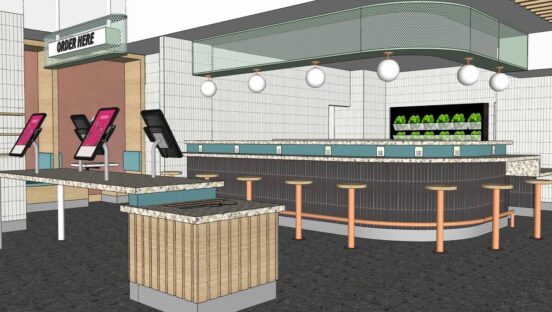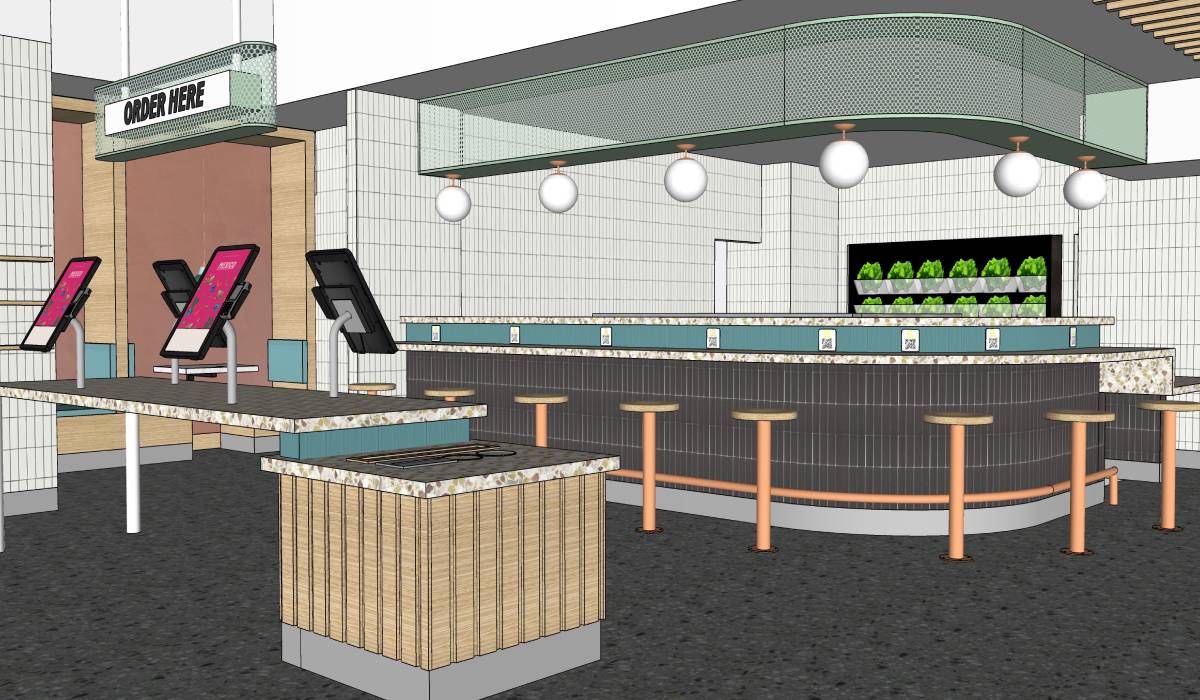Trends have accelerated over the last few years. Customers want meals prepared fast and served in a convenient fashion. Off-premises, drive-thru, delivery, and mobile are spiking, and traditional sit-down dining, at least in quick service, has taken a proverbial backseat.
Hence, two very different fast-casual chains, Chopt Creative Salad, based in New York City, and Café Rio Mexican Grill, housed in Salt Lake City, Utah, have stepped up by introducing digital cafes, which rely on drive-thrus, order ahead, and a smaller footprint.
At Chopt, which operates 84 company-owned retail stores (none franchised) in 10 states along the East Coast and South, digital, off-premises sales now constitute nearly 50 percent of overall revenue. In July, it introduced the brand’s first contact-free outlet in Arlington, Virginia, and plans on adding five “digital cafes” by the end of 2022.
Most Chopt stores require from 12–15 staffers to operate, but the smaller digital cafes make due with eight to 12, or three-quarters the typical staff, curtailing overall costs and reducing the complexity of hiring in a tight market.
Nick Marsh, who has been Chopt’s CEO for 15 years, says digital cafes emerged at the fast casual because “the definition of convenience continues to evolve, and the bar continues to be higher.”
Through the pandemic, customers got into the habit of ordering ahead and picking up food, “so we wanted to create a physical footprint that matched the convenience of the app. No lines, you walk through or come in, and order at the kiosk; it’s easy, accurate and fast,” he says.
Seating at the new digital cafes vary from 10 or 15 seats and up to 45. When Chopt tested its prototype café, Marsh says the brand learned some people still want seats. “That was the aha moment,” he says. “You don’t have to take things away to make the order experience easier.”
It also built a salad bar (an obvious pun) that faces the production kitchen. Many guests find the experience retro and enticing—they can see their salads being prepared while choosing among Chopt’s 60 different salad ingredients and 18 dressings.
The smaller cafés are also designed to be more sustainable and efficient. Marsh explains “the smaller footprint in the back of the house, and the new HVAC [heating, ventilation and air-conditioning] will drive a 30 percent reduction in kilowatt hours versus our average store.”
Despite reduced staffing, Chopt assigns employees who specializes in customer service. They welcome guests and assist them with any questions about ordering or the kiosks. “In the restaurant business, you are constantly focusing on hospitality and how to educate and welcome guests,” Marsh says.
Of the Virginia Chopt location, one Yelp consumer wrote, “The interior is sleek [minimal seating though] with a few kiosks you could use to order. There’s also a whole wall of shelves for online pickup orders and a TV screen to let you know which shelf your order is sitting.”
Marsh says the digital café is “ultimately more personalized when you combine, this physical footprint with the evolution of our app, and the loyalty program, and ability for customers to get perks and benefits. The whole ecosystem of the app and the store makes for the best experience.”
Café Rio Mexican Grill has 150 locations in 11 states, mostly out west but also in Maryland and Virginia, and all are company owned. It is slated to add 13 new outlets (with six already opened) in 2022.
To respond to customers, the brand debuted its Digital Café in 2021, which features drive-thru, curbside pick-up, digital kiosk, and mobile-app ordering. There are now six of them.
The increase in digital cafés stems from “aligning where the consumer is headed,” CEO Steve Vaughan says. Two-thirds of revenue derives from off-premises dining.
Café Rio’s new design highlights an open kitchen, enabling customers to watch meals prepared fresh to order. It removed the traditional cashier so guests can check-out digitally, either in-store, at the kiosk or app or online, before they arrive, or at the drive-thru.
To maintain hospitality, the unit assigns a floor ambassador to help with ordering and help customers use the kiosks.
The units average about 2,000–2,200 square feet, rather than the standard 2,400–2,600. “Some markets don’t justify the full investment,” Vaughan says, noting the digital cafes will allow the brand to open in areas it otherwise might not have at a cheaper cost.
The newer cafés continue to feature inside dining, but with fewer tables. They also require less kitchen space, and don’t need a dine-in line.
COVID accelerated this move toward digital cafes, Vaughan says. “People have been pressed for time has always been the case,” he says. But after COVID, people started picking up and continue to do so. Its third-party delivery sales were 8 percent pre-virus, doubled to 16 percent, and then tripled and now has returned to about 10 percent.
In the future, Vaughan envisions one-third to one-half of new eateries will be digital cafes. “It fits the customer’s lifestyle and helps us from a cost perspective because rents are lower,” he says.
These digital café skew more toward Gen-Xers and millennials who are more comfortable with ordering from apps and kiosks than Baby Boomers.
Asked what will determine the success of its digital café, Vaughan replies, “It’s customer acceptance. We have to continue to evolve with the customer, and as long as people are on the go and in a hurry, we have to change with them. If people decide to return to dining in, we’d change with them.”
These chains moving toward digital café achieve several goals at once, says Kevin Rice, an executive at Bounteous, who oversees the restaurant coverage at the consulting company, which specializes in digital media. Including: operating a new model that allows for cost-saving and more efficiencies such as reducing staff costs; and smaller footprints so start-up costs are lessened, whether renting or owning the land.
Sitting down and waiting for tables aren’t convenient for most consumers anymore. “The pace of life has intensified,” Rice says.
Rice adds quick-service eateries can improve hospitality through customer data platforms. This technology “captures all your customers’ data, preferences, what they order, so they can be communicated in a more personalized way,” he says.
Succeeding at operating digital café depends on mastering several skills, Rice says, like getting food orders accurately rendered every time and using geolocation services to fulfill orders fresh and hot to customers.
“We’re seeing fast casuals adapting digital and creating a new category, where they offer broader menus and higher quality ingredients, with all the ease of a [quick-service restaurant],” he says.









